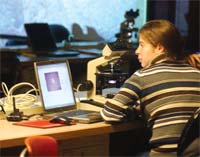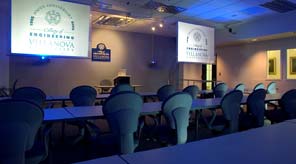Rich Media >> Get Rich Quick
The landscape of interactive technology continues to evolve, yet
few colleges are employing truly ‘rich’ media. Here’s how yours can be one of
them.

The word “rich” means different things to different people. Bill Gates can
rightfully be called rich, with an estimated net worth of $50 billion. But in
the world of academic technology, perhaps the most common use of the word “rich”
is in conjunction with “media.” Rich media has become synonymous with just about
every type of interactive technology, from collaborative whiteboards, video
conferencing, and real-time online tutorials, to Web-based meeting software.
These applications have emerged as the centerpieces of distance education programs
at colleges and universities across the country. However, as these interactive
technologies continue to evolve, experts say that only a handful of schools
are employing rich media that is truly rich. “A lot of what is available through
rich media today is a copy of what we already have in face-to-face education,” says Rich Mayer, a psychology professor at the
University of California-Santa Barbara who has studied rich media for the last decade. “What
we need is media that truly promotes learning—media that takes what already
g'es on in the classroom environment and makes it that much better.”
Redefining Med School with Rich Media
Technologists at the University of Vermont have answered this
call with authority. In August 2003, the university’s College of Medicine—where
all incoming medical students receive a laptop when they arrive on campus—unveiled
a new integrated medical curriculum that revolutionized the way medicine was
taught. Instead of separately teaching subjects such as gross anatomy or the
nervous system, the school reorganized its curriculum to embrace a more holistic
and interconnected approach.
Under the new system, for instance, students would learn about the physiology
of the heart while they dissected one. According to Jill Jemison, eLearning
manager for the College of Medicine, the idea was to build a new curriculum
that enables students to see, at all times, the medical relevance of every action
as it relates to patients.
University officials dovetailed the debut of their new curriculum with a new
technology component that revolved almost exclusively around rich media. Working
within the confines of a learning management system from Blackboard (www.blackboard.com), IT staffers developed a bevy of new interactive technologies designed
to incorporate real-world learning from real-life doctor/patient situations.
This effort began with exam-building software from Respondus (www.respondus.com)
that enables faculty members to upload existing or new question pools from word
processing programs, and combine those with audio or video files in the Blackboard
system, to deliver Web-based tests. All questions are approved by a committee,
and all questions correspond to 900 “competencies,” or learning objectives that
UVM faculty have identified as central to what it takes to become a doctor.
| INSIDE RICH MEDIA |
| Will video enhance this lesson? D'es an audio file add anything other than bandwidth? By asking questions like these, Bloomsburg University educators get students to think critically about how to apply the technologies they’re learning, and how to apply those lessons to field experiences in their internships and beyond. |
“The way we do it, all learning activities are informed by this giant database
of what someone needs to know,” Jemison explains. “When you take a step back
and think about how we’re using this technology to make sure our people are
qualified, I’m not sure we can get media richer than that.”
But there’s more. In addition to creating and distributing exams with the help
of interactive technologies, UVM’s approach also uses rich media to make sure
no one is cheating. Thanks to technology called Securexam from Software Secure
(www.softwaresecure.com),
the school administers Web-based exams in a secure environment that literally
locks down all other computer functions until the test is complete.
In order to make sure students take exams in a controlled environment, test-taking
students must report to proctored exam rooms and log on to their laptops. Securexam’s
browser automatically populates part of the exam password, based on its encryption
technology; for added security, the rest of the password is supplied by the
proctor. The technology even facilitates off-site exams, too. Thanks to the
lockdown browser approach, all that the students need in order to take the test
outside of the college’s Burlington campus is a computer room and a proctor.
The final piece of UVM’s rich media puzzle comes in the form of SearchLX,
a powerful search tool from Learning Objects (www.learningobjects.com).
The tool enables students and faculty members alike to search all of the content
in the Blackboard learning management system. Jemison bills it as a “stellar”
review tool for students, giving them access to files in a variety of genres:
written words, audio, video, and more. She notes that the review tool is particularly
useful for some of the image-based disciplines such as histology and micropathology,
both of which boast beautiful image sets.
In the case of surgery rotations, the tool also enables students to use their
laptop or PDA to call up a video of a surgical procedure just seconds before
they perform the actual procedure, learning as much through first-hand emulation
as through plain old study.
“Given that we are a medical school, our faculty members are faced on a daily
basis with innovations in revisiting science,” Jemison says. “Rich media allows
for that kind of innovation by innovating itself, and by reassuring users that
they’re getting even more than they possibly could under the old system.”
The
Incubator
UVM’s rich media applications are blazing new trails in modern-day rich media
usage. And at
Bloomsburg University (PA), academic technologists
affiliated with the university’s Institute for Interactive Technologies (iit.bloomu.edu)
have staked their careers on making sure rich media products get even richer.
Through this program which began online in 1997, educators work solely with
distance education students interested in developing the next wave of rich media.
In the process, they employ the latest and greatest forms of rich media and
interactive technologies, says IIT Assistant Director Karl Kapp.
The program’s rich media immersion begins with homegrown audio sensor software
that allows instructors to engage in two-way audio communication with their
students. Next, with the help of Java-based Symposium conferencing software from
Centra (www.centra.com),
instructors can also break their classes into groups, and students in those
groups can interact in real time through collaborative whiteboards.
To further enhance communication between students and instructors, IIT utilizes
ECP Connect, a program from Interwise (www.interwise.com)
that manages data and voice conferencing. It has also employed the new Breeze
product from Macromedia (www.macromedia.com),
which essentially is designed to enable users to participate in online meetings
and conferences where they can share presentations, view videos, conduct polls,
chat, and more. “This combination of technology enables us to quite literally
sketch out ideas as they materialize,” says Kapp. “The notion of doing that
online is simply revolutionary.”
| INSIDE RICH MEDIA |
| A number of rich media experts say that a surprising number of students fall victim to issues pertaining to firewall controls. The problem arises because at a time when identity theft and other security threats are at an all-time high, few students have their personal firewalls configured to allow incoming data to stream unchecked. |
While Breeze is the newest component of IIT’s repertoire, the real highlight
of the program is its commitment to rich media applications that incorporate
real-time video as a learning tool. The school’s reliance on digital video conferencing
is nothing unique, but in addition to broadcasting video-over-IP along with
voice and text, IIT also incorporates Macromedia’s Captivate software to record
an instructor’s onscreen mouse movements for those hard-to-follow instructional
lessons. With the help of this step-by-step learning tool, IIT offers rich media
classes in many of the products actually used to create the rich media: Dreamweaver,
Flash, and Authorware from Macromedia, as well as Photoshop from Adobe (www.adobe.com),
and more.
The IIT program is a one-year endeavor, followed by an internship or dissertation
at program completion.
In addition to the abundance of technological knowledge,
the program also strives to impart to students something about the theory of
rich media. Here, Kapp says the emphasis is distributed in every class where
educators are encouraged to help students uncover which specific applications
of rich media are truly rich. Will video enhance this lesson? D'es an audio
file add anything other than bandwidth? By asking questions like these, Bloomsburg
University educators get students to think critically about how to apply the
technologies they’re learning about, and how to apply those lessons to field
experiences in their internships and beyond. “
 |
AT UMV, RICH MEDIA
applications are changing exam
process, medical study, and more. |
At the end of the day, there’s no better way to teach students about interactive
technologies than to use interactive technologies,” says Kapp. “Everything about
our program—from the subject matter to the lessons themselves—is designed to
embrace the richness of rich media completely.”
Alternate Approaches
At the Wharton School of the University of Pennsylvania, technologists
have explored different types of innovations in interactive technologies for
synchronous communication, but one of their most successful undertakings operates
asynchronously, as faculty members and students see fit. These rich media efforts
revolve around a collaboration program called Webcafé, a glorified bulletin
board designed to facilitate collaborative study partnerships, as well as extracurricular
project planning for activities in and around the Philadelphia community.
The effort began back in 1998, as a portal for students in only 25 select classes.
By 2003, every student in the school’s 450 business and management classes was
given the opportunity to use it. Today, Webcafé is open to all students and
faculty members, plus some staff, with 7,500 concurrent users at any given time.
Rob Ditto, senior IT project leader, says Webcafé has become one of the most
commonly used technologies on Wharton’s campus, second only to e-mail.
To use the system, users simply log on with a standard Web browser, from wherever
they might be. Behind the scenes, Webcafé runs on software from EMC Documentum
(www.documentum.com),
an enterprise content management tool that helps users create and share any
number of files, including digital text documents, engineering drawings, still
images, audio and video files, and many others. Ditto says he wrote a separate
program that enables students to upload assignments to a secure server, and
allows faculty members to exchange comments with students in a secure environment
that stores the comments as part of a gradebook database. The software also
features more lifestyle-oriented collaboration spaces, which students use for
more practical purposes such as maintaining a database of summer sublets, or
voting on which stocks are the best bets for investment.
 |
BANDWIDTH PROBLEMS don't impede distance
educators at Villanova, simple workaround works. |
“For both students and faculty members, this simple approach really d'es enhance
everyday goings-on around Wharton,” says Ditto. “We found this was the best
way to build upon what happens in our classrooms.”
Because it is asynchronous, the Wharton solution addresses one of the most
prevalent stumbling blocks for rich media: bandwidth. Generally speaking, most
interactive technologies sap gigabytes of network bandwidth, so institutions
that run mission-critical applications on the same network may not have much
bandwidth left for the rich media apps.
Another element of the bandwidth issue revolves around student connections:
Streaming connections require 150 Kbps of bandwidth, or roughly one-third of
standard DSL line throughput. Short of requiring all students to have a connection
of minimum speed, there’s no foolproof way for a school to ensure that all students
are connecting at speeds that enable them to follow instructors in real time.
In most cases, when bandwidth is an issue on either side, at least some students
will experience five- or 10-second delays, effectively rendering the benefits
of rich media useless.
To ensure that bandwidth isn’t a problem for their students, technologists
at the College of Engineering at Villanova University (PA)
have whipped up a blend of old-fashioned technology and even more archaic transportation.
At the end of every distance education class, IT staffers help faculty members
wrap class materials into Zip files, usually no larger than 150MB. Next, depending
on a student’s connection, the staffers either make these Zip files available
for standard download, or they burn the files onto a CD-ROM and then spend $5
or $10 to overnight it via the US Postal Service. With this approach, Seán O’Donnell,
director of Distance Education, says that instead of downgrading quality to
serve the lowest common denominator, the school is able to respond to the individual
needs of students with all types of connections.
“We’re ready for anything,” he boasts. “But believe me, if you’re a distance
education student paying for one of our distance education classes, you wouldn’t
want to go into the race with a Pinto, you’d want a Porsche.”
Stumbling Points
As O’Donnell explains, schools can work to eliminate bandwidth as a problem
for rich media on campus. One obstacle that has established itself as a more
formidable challenge to the development of rich media is “educator comfort.”
According to IIT’s Kapp, educators in fields such as engineering and science
are comfortable enough with technology to explore new products as they come
out. However, in fields such as English and history, where educators don’t rely
on technology nearly as much or as frequently, Kapp says faculty familiarity
with rich media drops dramatically, necessitating a learning curve that can
debilitate a push for change.
In the latter cases, Kapp says faculty members are most likely to use rich
media to do nothing more than mimic the experience in the classroom. While these
educators might go through the trouble of hooking up a streaming videofeed during
lectures, the application won’t offer anything beyond this feed itself, a poor
use of rich media, by any standard.
One way to increase educator comfort levels with rich media is to make it easy
for instructors to take advantage of the technology as a way to supplement what
g'es on in class. At Drexel University (PA), for instance,
the school’s IT department launched what they call a “Rich Media Drop Box” to
automate the process of digitizing content to be used with interactive technologies.
The system hinges upon command line encoders from Sonic Foundry (www.sonicfoundry.com),
which cost about $20,000 apiece.
To use the system, faculty members drag and drop text, audio, and video files
into a special folder on the school network; the files are then transported
to an encoding farm, where they are converted into digital content that can
be used in just about any rich media environment. Access to this encoded content
is through RSS syndication. According to John Morris, Drexel’s coordinator of
Academic Technology and Web Services, the school processed more than 400 objects
during a recent 10-week pilot program with 10 faculty members.
“Once the faculty members learned that this made it easy for them to digitize
content, the Drop Box was something that really resonated with our faculty members,”
he says. “One way to ensure rich media is rich is to make it accessible for
everyone.”
Even with accessibility bases covered, rich media presents two other sizable
challenges for colleges and universities looking to increase interactivity across
the board. First is security—Villanova’s O’Donnell and a number of other rich
media experts say that a surprising number of students fall victim to issues
pertaining to firewall controls. The problems arise because at a time when identity
theft and other security threats are at an all-time high, few students have their
personal firewalls configured to allow incoming data to stream unchecked.
What’s more, when students log on to a rich media application, and their operating
system asks them if they want to allow the stream through the firewall, many
students decline because they are afraid of leaving their machines vulnerable
to attacks from elsewhere on the Web.
Perhaps the biggest challenge with rich media is the way a school uses it to
support human cognition. Mayer, the UCSB psychology professor who also authored
the recently released Cambridge Handbook of Multimedia Learning (Cambridge University
Press, 2005), has studied the cognitive science since 1995, and insists that
there’s a huge difference between a technology-centered approach and a learner-centered
approach.
In theory, Mayer says that rich media can be a valuable tool. In practice,
however, he insists that few, if any, schools actually use the technology the
way they should. Looking forward, Mayer notes that in order for rich media to
be more than just a fad, inventors must devise a way for users to rely upon
rich media for something that extends and amplifies the ordinary classroom experience
without detracting from it at all.
“We’re not even close to seeing rich media that, for lack of a better word,
is rich,” he says. “The technology has the opportunity to revolutionize learning,
but if it’s developed poorly, we will turn off more people than we attract.”